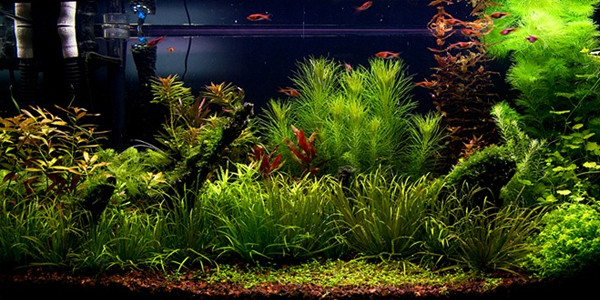In the aquascaping world, the two most commonly implemented styles are Nature aquascaping style and Dutch aquascaping style. Iwagumi aquascaping style is slowly gaining popularity though.
As the oldest aquascaping style, the Dutch style focuses primarily on the growth and arrangement of aquatic plants.
Utilizing numerous aquatic plants, a beautiful Dutch aquascape implements a rich contrast using subtle color and texture, but also maintains a high density of plant life.

An aquascaper hoping to design a Dutch style aquascape must be able to see and nurture the growth of plants so the end result is in line with his or her intentions, which requires a solid understanding of how to cultivate aquatic plants.
Apart from the cultivation of the plants, there are numerous other key aspects to consider such as the health of your aquascape, the selection of the plants, and the overall layout.
Table of Contents
Understanding the Dutch Aquascaping Style
Dutch aquascaping focuses mainly on the arrangement and growth of plants in an aquarium. Setting up a Dutch aquascaping style involves establishing a balance between plant variety, density, simplicity, and color. 70% of the plants chosen must be aquatic plants.
Main Components

The aquatic plants of your design are the focal point of a Dutch aquascape.
As a result, it is incredibly important for the aquascaper to understand how to plant, combine, and organize the plant life so the final arrangement is aesthetic and balanced.
Unlike a Nature style aquascape, Dutch aquascapes are not designed to mimic a natural setting or specific ecosystem.
The development of this style is a testament to the intricacy in envisioning your end product and cultivating the system to watch it grow and become what was originally imagined.
Basic Design and Layout

Establishing a balance of plant density, variety, color, and simplicity is essential to creating a Dutch aquascape.
Terracing is a common practice that enables the aquascaper to convey depth in using aquatic plants.
By creating levels and areas of a particular species, the aquascape is more efficiently organized and, in turn, creates contrast and other aesthetics.
70% Aquatic Plants
Over 70% of the aquarium should be planted with various species of aquatic plants.
However, keep in mind that simplicity is a common theme in Dutch aquascapes; having too much variety or color can have a negative impact on the end result.
Utilizing the “rule of thirds” and creating single focal points are best practices in maintaining density, minimalism, and organization in your aquascape.
Finally, color, contrast, and space must also be considered when planting your aquascape.
The contrast between objects is essential to the overall aesthetic and the use of space creates organization between your plants.
Recommended Plants and Fish

A general rule when selecting your plants is to apply three plant species per foot.
This creates the necessary color contrast and variety in the Dutch style. Stem plants are recommended due to their rapid growing rates, size, and color.
Common Plants in Dutch Aquascaping Style
Most common species used in Dutch aquascaping are:
Saurus Cernuus and Lobelia Cardinalis
These plants grow low and close to the layer of substrate in your aquarium. In addition, they help create pathways, angles, and depth.
Hygrofilia Corymbosa and Limnophila Aquatica
These species provide a bold visual aesthetic in your aquascape. As a plant that grows quickly and with large stems, they provide a different shape and size to the overall scene.
Cryptocoryne
Small earthy plants often used as the foreground of the aquascape.
Alternanthera Reineckii, Ammania, Rotala, or Tiger Lotus
Large and colorful, these species act as the main points of contrast in the Dutch design.
Java Moss
A species that is commonly used to create contrast and focal points throughout the design, typically placed in between plant species in an effort to create a seamless transition between the elements in your aquascape. It is also an easy-to-maintain aquatic plant.
Common Fishes in Dutch Aquascaping Style

Fish are also used in Dutch aquascapes, but sparingly. Schooling fish are recommended, though Congo tetras and Angelfish are also good choices for Dutch aquascapes.
Challenges of Dutch Aquascaping Style

Dutch aquascaping is defined by its variety, contrast, and organized chaos. Each plant used in a Dutch aquascape serves a purpose in creating layers of color and varied focal points without any sort of hardscape.
As a result, the main challenges around this style of aquascaping stem from the knowledge required to create the vision of your design and maintaining these living aquatic plants.
Equipment is required to monitor and maintain the lifecycle of your aquatic plants as well as daily liquid fertilizer and trimming of the plants to maintain a healthy environment.
Conclusion

The Dutch aquascaping style is defined by its use of many different plants, but it also distinguishes itself from other aquascaping styles through its use of terraces and space.
Creating a scene of organized chaos simultaneously facilitates a balanced and calm ecosystem of aquatic plants and fish.
As a result, the background-foreground play is a difficult balancing act between creating focal points and contrast between each object of your design.
The key to success for the determined aquascaper is to be able to imagine your end result as you begin your design. While difficult to imagine at first, proper care and cultivation will create an end result that is natural and beautiful.

5 thoughts on “Understanding Dutch Aquascaping Style”
I have been keeping aquarium for last 30years would love to learn about aquascaping . saw your site and was awe struck .
Thanks! =) Is there anything in particular you want to know?
What’s the name of the plant on the far right under Basic Layout and Design. It’s like underwater Lily pads
i am amazed
by you i am also having a mini dutch aquarium
What are your opinions on using shrimp as a source of color in an aquascape? (ike Cherries or Amano)